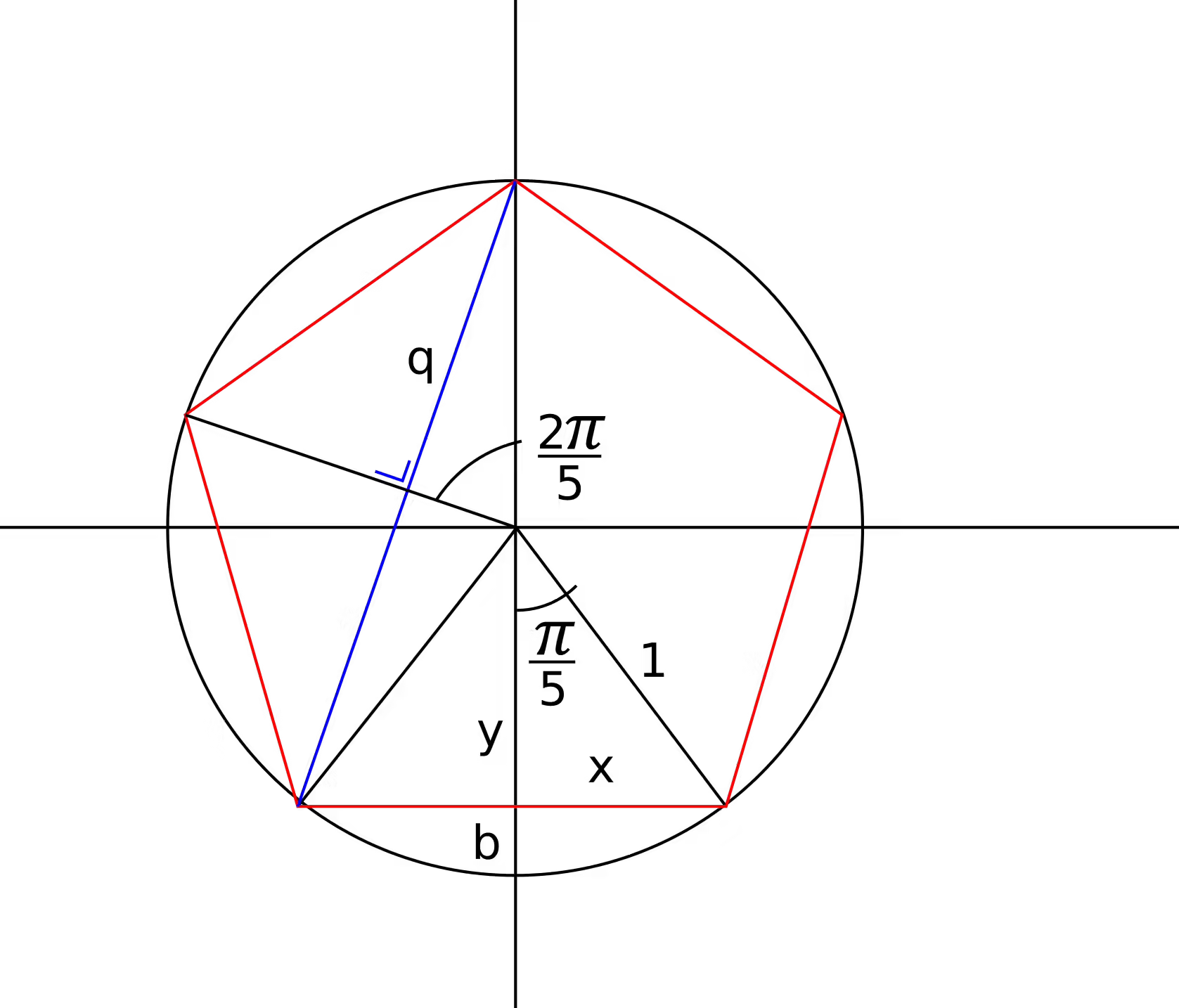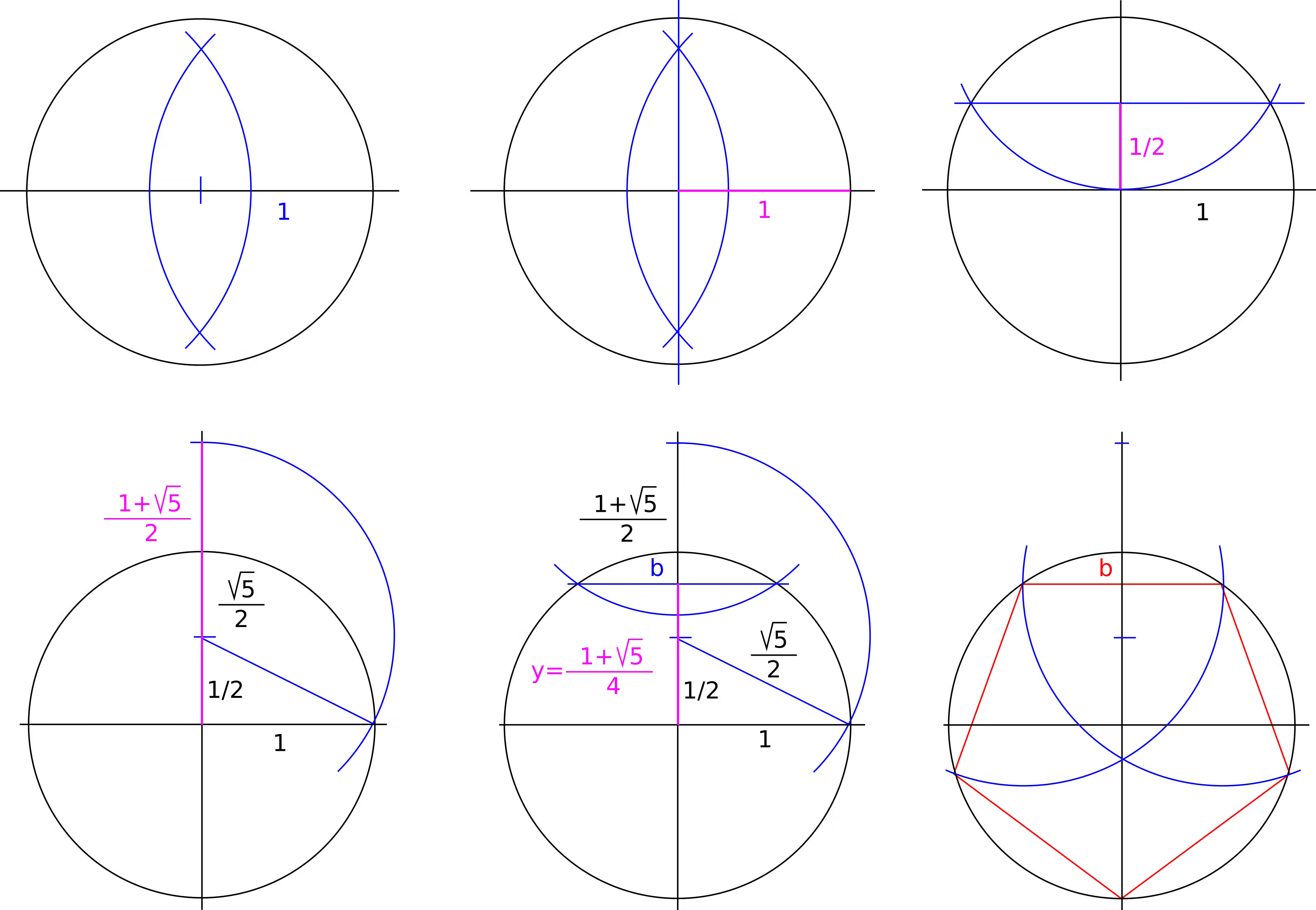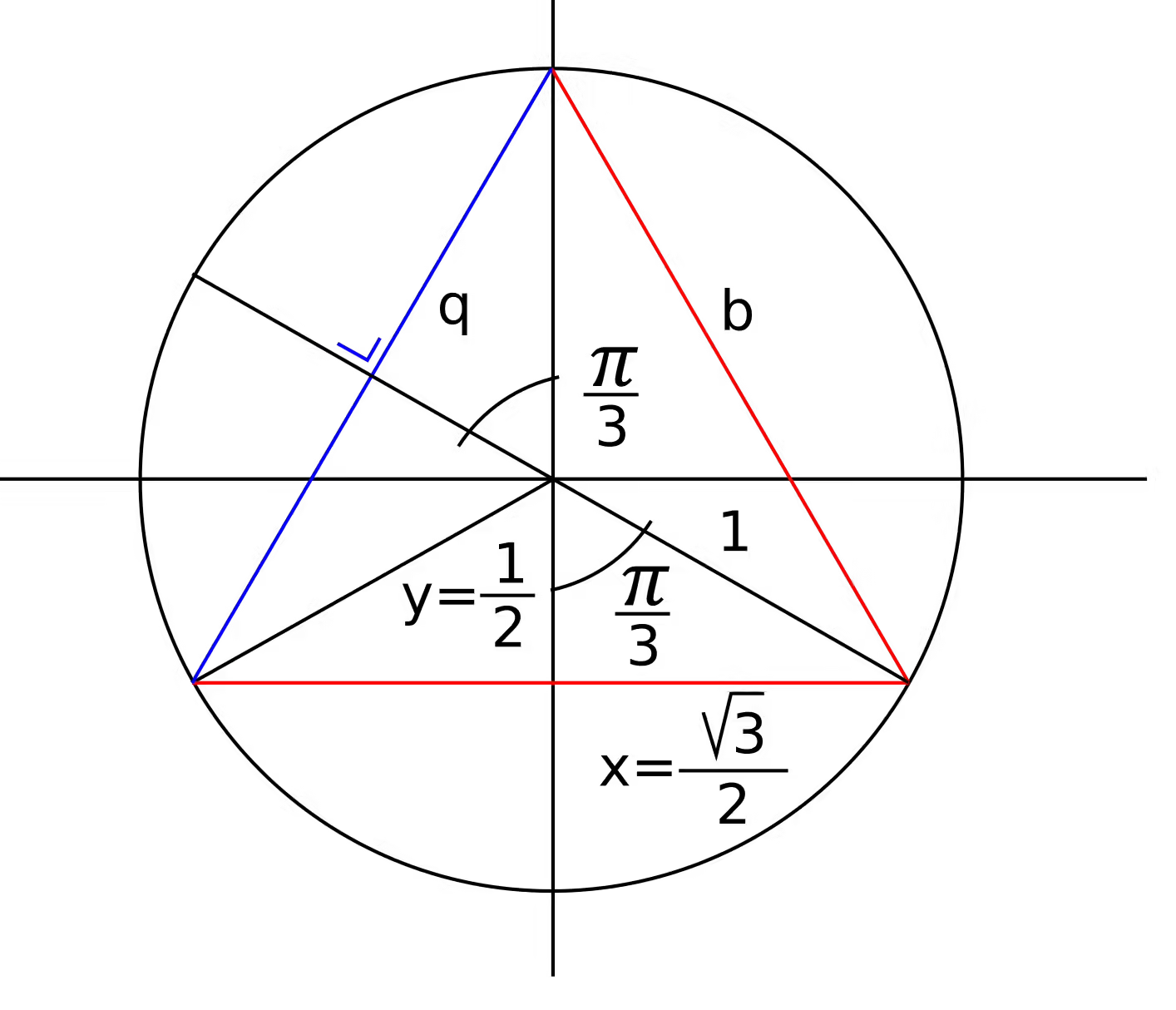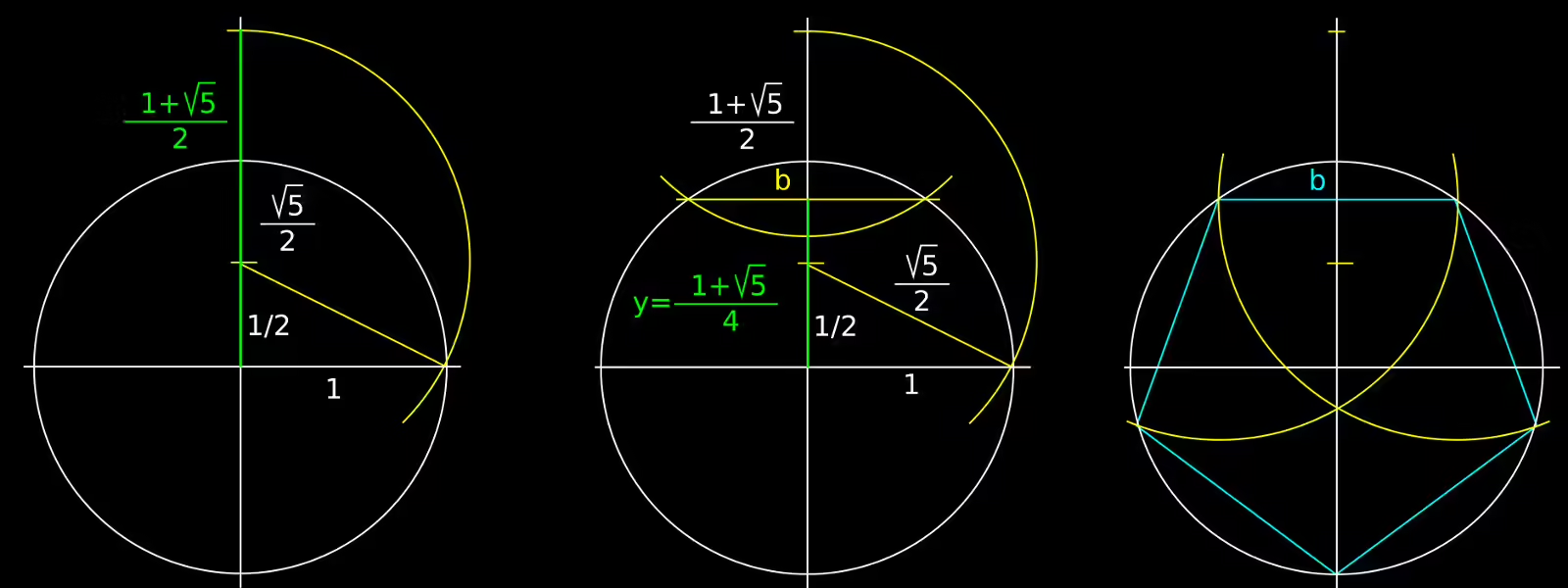I like solving little maths puzzles, deriving known results using nothing more complicated than secondary school level trigonometry, algebra and maybe a little calculus. The one below is actually two puzzles, but both have to do with regular polygons.
Part 1 Approximating π by the perimeter of a regular polygon
Can one approximate $\pi$ by the perimeter of regular polygon with increasing numbers of sides inscribed in a unit circle, so starting with a triangle, then a hexagon, a dodecagon,… ? You may say that is obvious: the more sides, the closer the polygon approximates a circle. But I still wanted to work out the proof.

From Figure 1, clearly
\begin{equation} b=2\,sin\frac{\alpha}{2}\label{eq:1} \end{equation}
For a polygon with n sides, we have
\begin{equation} \alpha=\frac{2\pi}{n}\label{eq:2} \end{equation}
So we can express the lenght of the side of a polygon as a function of the number of sides as
\begin{equation} b(n)=2\,sin\frac{\pi}{n}\label{eq:3} \end{equation}
The perimeter of a regular polygon is obviously
\begin{align}
n.b(n) & = & 2n\,sin\frac{\pi}{n}\label{eq:4}
& = & 2\pi\frac{sin\frac{\pi}{n}}{\frac{\pi}{n}}\nonumber \end{align}
We know that
\begin{equation} \underset{x\rightarrow0}{lim}\frac{sin\,x}{x}=1\label{eq:5} \end{equation}
This is easily proven using de l’Hôpital’s
rule
Using $x=\frac{\pi}{n}$ it follows indeed that
\begin{equation} \underset{n\rightarrow\infty}{lim}n.b(n)=2\pi\label{eq:6} \end{equation}
In other words the perimeter of successive polygons inscribed in a unit circle does approach $2\pi$ – which of course comes hardly as a surprise.
The following code implements this starting from a polygon with a given number of sides $n$ . The argument $h$ is half of the length of the side, and $n_{max}$ is the number of iterations. What the algorithm does is recursively creating polygons with $n, 2n, 4n, 8n, … $ sides. The example starts from a triangle so $n=3$ and $h=\sqrt(3)/2$.
-- n: # sides of the polygon
-- h: half of the length of a side
approx_pi n h n_max
| n == n_max = n*h
| otherwise =
approx_pi (2*n) (sqrt ((1 - sqrt (1-h*h) )/2)) n_max
-- e.g starting from a triangle.
main = print $ approx_pi 3 ((sqrt 3)/2) (3*2**14)
What I find interesting is that every prime polygon produces a different series but they all converge towards $\pi$.
Part 2 How to construct a pentagon using a compass and a ruler
People have worked out how to construct a pentagon using only a compass and a ruler long ago. Nevertheless, I wanted to derive the construction from first principles.

The length of a side of a pentagon
From Figure 2 we can write down some straightforward relationships between the length of a side of a pentagon (b from the previous part) and the angle of the arc, $\frac{2\pi}{5}$.
\begin{equation} x=\frac{b}{2}=sin\frac{\pi}{5}\label{eq:2.1} \end{equation}
\begin{equation} y=cos\frac{\pi}{5}\label{eq:2.2} \end{equation}
\begin{equation} x^{2}+y^{2}=1\label{eq:2.3} \end{equation}
\begin{equation} q = 2sin\frac{2\pi}{5}=4sin\frac{\pi}{5}cos\frac{\pi}{5}\label{eq:2.4}\end{equation}
Substitution of Eqs. $\ref{eq:2.1}$ and $\ref{eq:2.2}$ gives
\begin{equation} q = 4xy\label{eq:2.5}\end{equation}
Now we consider the right triangle with hypothenuse q:
\begin{equation} q^{2} = x^{2}+(1+y)^{2}\label{eq:2.6}\end{equation}
Substitution of Eq. $\ref{eq:2.3}$ in the RHS of Eq. $\ref{eq:2.6}$ and refactoring gives:
\begin{equation} q^{2} = 2+2y\label{eq:2.7}\end{equation}
Substitution of Eq. $\ref{eq:2.3}$ and Eq. $\ref{eq:2.5}$ in the LHS of Eq. $\ref{eq:2.7}$ and refactoring gives:
\begin{equation} (4-(2y)^{2})(2y)^{2} = 2+2y\label{eq:2.8}\end{equation}
Now we define $z=2y$ and rewrite Eq. $\ref{eq:2.8}$ as:
\begin{equation} (4-z^{2}).z^{2}=2+z\label{eq:2.9} \end{equation}
Which after more refactoring finally gives
\begin{equation} z^{2}(2-z)-1=0\label{eq:2.10} \end{equation}
This is a third-order equation but fortunately there is an obvious root for $z=1$. After some factorization we obtain the remaining second-order equation:
\begin{equation} z^{2}-z-1=0\label{eq:2.11} \end{equation}
The roots of this equation are:
\begin{align}
z & = & \frac{1\pm\sqrt{(-1)^{2}-4.1.(-1)}}{2.1}\label{eq:2.12}
& = & \frac{1\pm\sqrt{5}}{2}\nonumber \end{align}
This is actually a very famous equation and its positive root is known as the Golden ratio.
\begin{align} \phi & = & \frac{1}{a} & = & \frac{a}{1-a}\label{eq:goldenratio} \end{align}
Clearly y as defined is positive so $y=\frac{z}{2}=\frac{\phi}{2}$ or
\begin{equation} y=\frac{1+\sqrt{5}}{4}\label{eq:2.13} \end{equation}
From Eq. $\ref{eq:2.13}$ we can express b in terms of y using Eqns $\ref{eq:2.1}$, $\ref{eq:2.2}$ and $\ref{eq:2.3}$:
\begin{equation} b=2\sqrt{1-y^{2}}\label{eq:2.14} \end{equation}
And so we obtain the expression for the length of the side of a pentagon as
\begin{equation} b=\sqrt{\frac{5-\sqrt{5}}{2}}\label{eq:2.15} \end{equation}
Construction of the pentagon
The remaining question is then, how do we construct a line of length b using a rules and compass?
We do this indirectly, by constructing a line of length y as shown in Figure 3. First, we construct a line of length 1/2. Then the hypothenuse of the right triangle with sides 1/2 and 1 has a lenght of $\frac{\sqrt{5}}{2}$. We add this to the 1/2 by drawing an arc of radius $\frac{\sqrt{5}}{2}$ using the compass. This way we get a line of length $\phi = \frac{1+\sqrt{5}}{2}$. Dividing this into two gives y and through the way we constructed this, we immediately get b as well and so we can construct the pentagon using arcs of radius b.

A hidden triangle
The equation we solved to obtain y (Eq. $\ref{eq:2.10}$) is a third order equation, and its other positive root is $z=1$. This shows in a way the danger of transforming a geometry problem into algebra: only one of these roots, $z=\phi$, corresponds to a solution of our geometric problem.
But there is also a geometric interpretation for the root $z=1$. Substitution of $y=1/2$ in the equations for results in $q=\sqrt{3}$ and $b=\sqrt{3}$, in other words a regular triangle inscribed in the unit circle.

